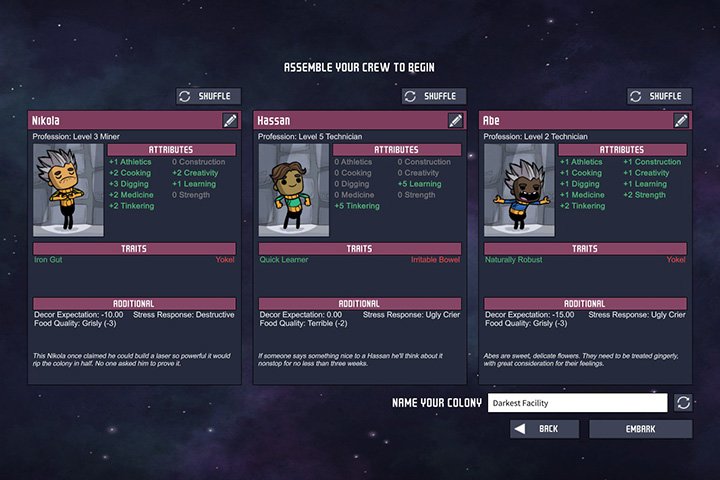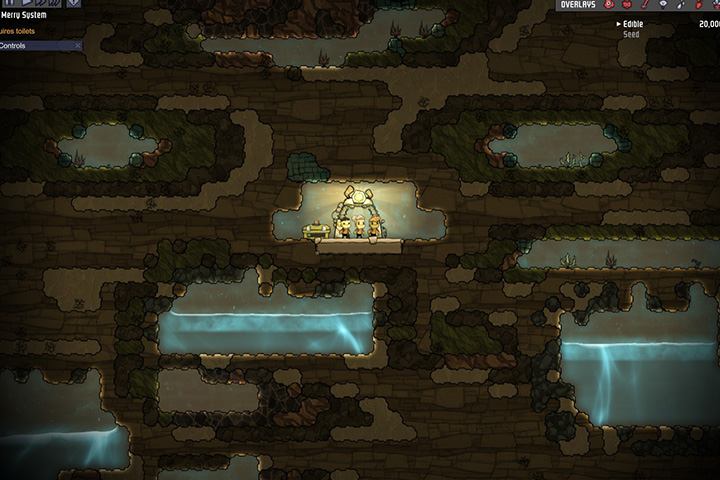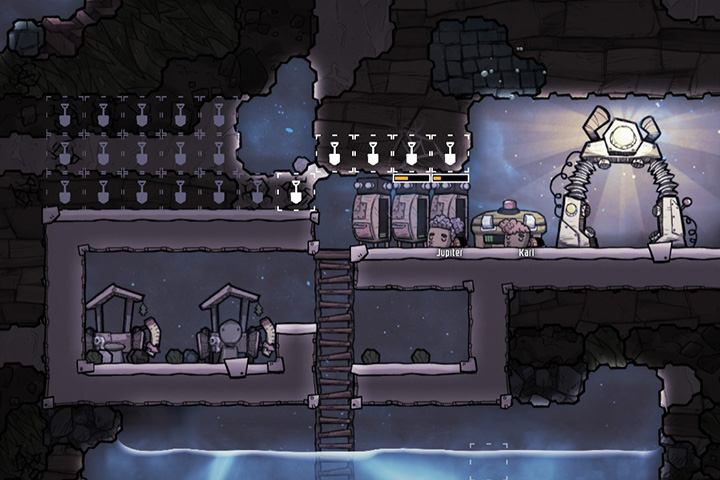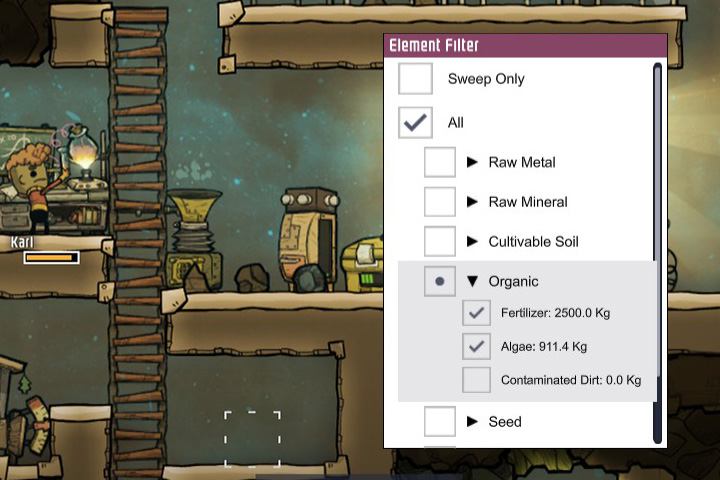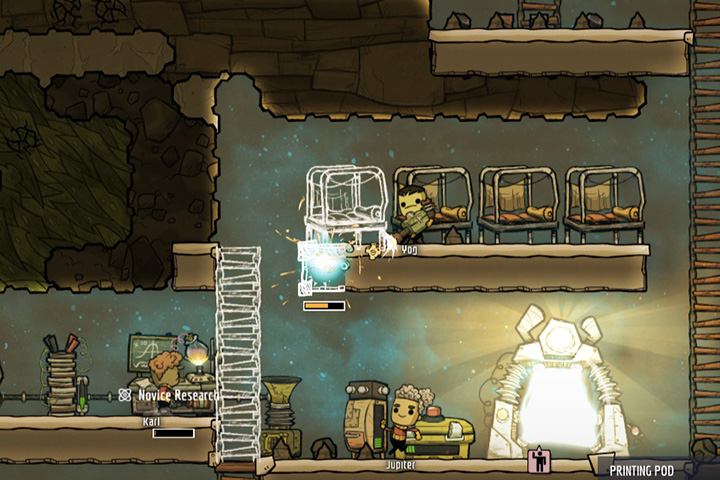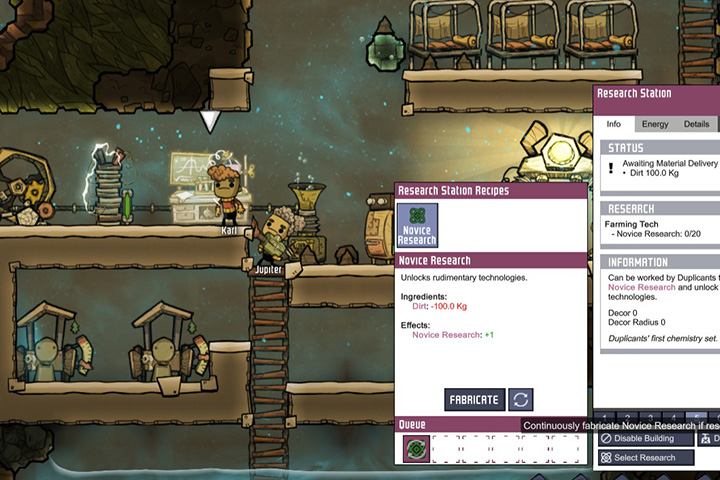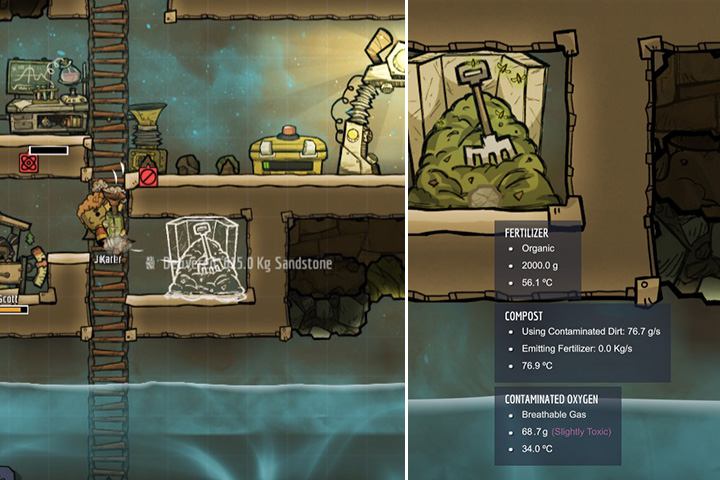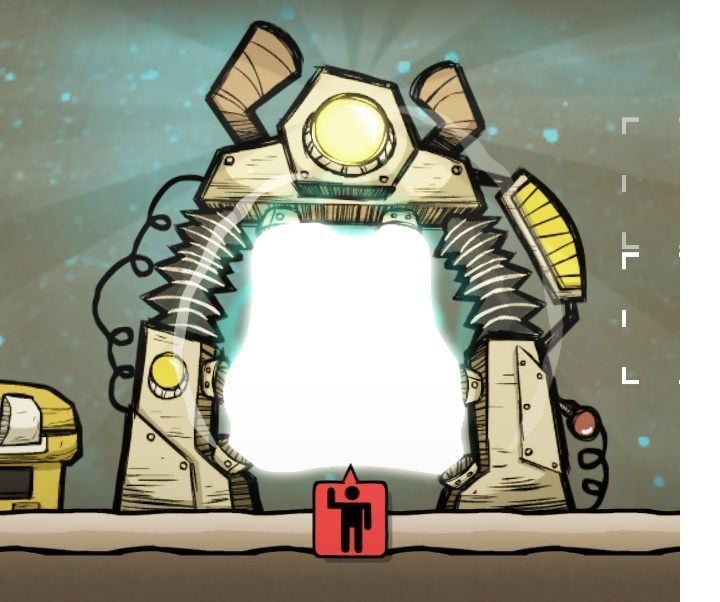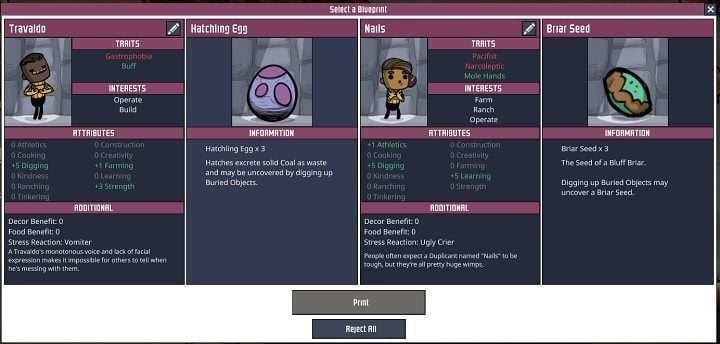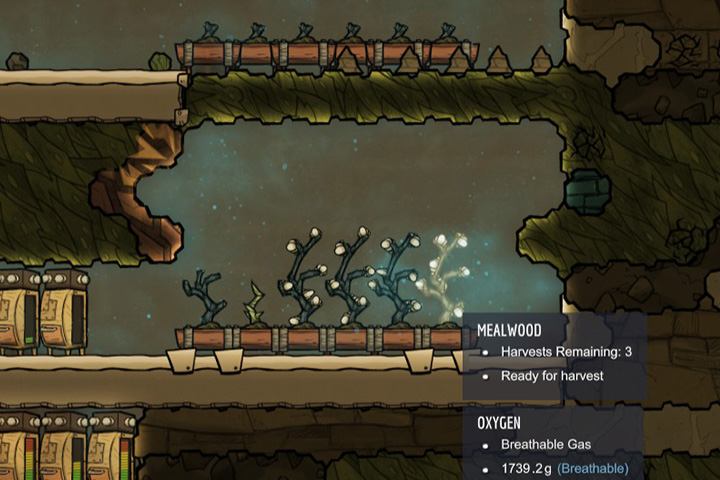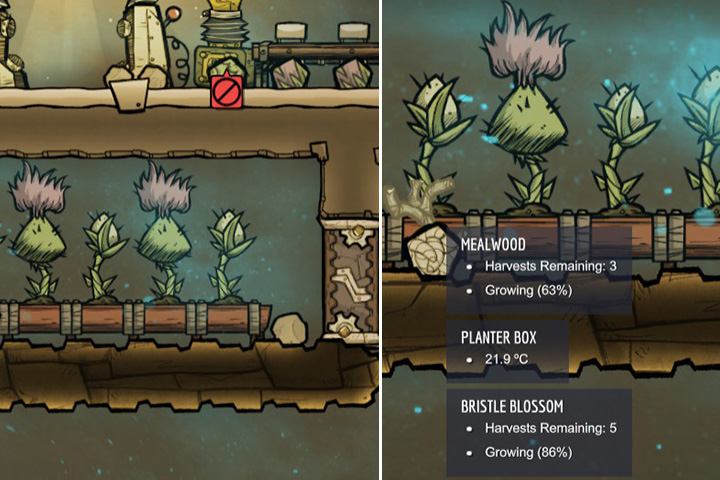Beginner Guide
Select the right duplicates. The correct choice of the first 3 duplicates is very important. Try to select specialists in some field, that is, people who have more than 4.5 points in a given field. Search for a good digger/miner, preferably with high athletics and ideally with high strength, so that he can carry more materials. Digging tunnels and creating new rooms will be your daily bread during the game. The next character should preferably have a high construction skill and, if possible, lots of creativity. The third and most important role for most of the initial stage of the game is a scientist. He must have a high learning statistic. It gives not just a bonus to research, but it also earns more experience in other areas. Later on you can also choose a good cook. However, you will be oscillating around the first three roles. Medicine strengthens the body’s health and tinkering affects the use of machines. It is also used when repairing broken machines and devices.
All of them have modest requirements when it comes to Decor and Food. Two of them are not exactly the scientific types, but the third one is a good material.
Each character can be changed as many times as you want with thr Shuffle button. You should keep changing the first duplicants until all skills are green – you won’t have any specialists, but this will provide a faster start for your colony. Specialists in a discipline have at least 4.5 skill points assigned to it. You should quickly determine how will you develop the colony and then adapt the strategy to the blueprints your duplicants obtain. Traits window presents positive and negative traits of the colonist, usually there are two of them although sometimes there might be even five. You should check these traits when selecting colonists.
- Recommended; Driver’s Longs (less oxygen consumption), Iron Gut (can eat anything without unpleasant consequences), Naturally Robust (increases overall immunity of the body)
- Avoid; Flatulence (bloating, the duplicate will produce contaminated oxygen), Mouth Breather (needs twice as much air to breathe), Biohazard (the duplicate is more susceptible to diseases).
- Neutral; Narcoleptic (can sleep at any moment), Scaredy-Cat (cannot fight), Yokel (cannot conduct research).
Below there are interests. Performing these tasks will reduce the stress level of a duplicant. Underneath the interests there are attributes – levels of specific skills. Below them there are vulnerabilities of the duplicant – there you will find information how the duplicant reacts to stress, environment beauty, and quality of meals.
Once the stress levels of a character reach 100%, your people may react in one of the following ways: they will vomit (Vomiter), cry (Ugly Crier), gorge on food (Binge Eater), or begin smashing your base to pieces (Destructive). It is much better to choose the characters that have the first feature, the vomit is simply contaminated water, which can then be used if you build the base properly. Cry, on the other hand, will affect others, increasing their stress levels. A glutton may become a deadly threat if you have limited food supplies, as he will eat through your reserves, leaving nothing for the others.
To summarize: In the beginning you should select versatile units that can perform every type of work – this will enable the starting characters to work more efficiently, you won’t need to add more of them. Once you reach a point where the base duplicants aren’t enough and their work takes too much time, you should select characters that have more than 4 points of a single ability – you should preferably look for duplicants with high level of Digging and Learning.
The Beginning
Lots of algae and water. But the metals are missing, they are located only in the upper part.
1. Get acquainted with your surroundings. Maps are generated randomly, the same concerns the amount of resources and water. Sometimes you will find many caves with creatures or masses of buried objects around your starting location. At other times you will find abundant algae stocks or plenty of copper ore. It is worthwhile to find out at the very beginning, towards which side to dig and improve the base in order to get the necessary resources. In the picture above you can see three large water tanks with some Fertilizer around them. There are also 4 caves surrounded by algae and oxylite, which produces oxygen. Thanks to that, I will not have to rush oxygen production. In the caves, you will find plants, which you will soon grow; you just have to research your first technologies. Make sure you collect as much seeds as you can at this point. The only thing missing at the moment, is the supply of metal. The metals are quite high up, above the fourth cave. There is a vacuum right above the copper ore deposit. It will draw in air and dilute the level of gases in the base. I will avoid this area for now. The area is also lacking in buried objects, where I could find more seeds. Given this shortage, my fields will not be too bountiful at the beginning of the game.
An outhouse is crucial!
2. Expand your base and build an outhouse and some storage. The first step is to create a place for the outhouse. You have a supply of food and air. There is always a large supply of Oxylite around your printing pod. It will last for 2-4 days. However, if you do not have an outhouse, you will soon learn first-hand about the danger of your cave being drowned in contaminated water. Now build a few storage compactors, so that resources are not scattered all over the place. This is bad for the well-being of your duplicates. It will also be easier for them to build, without having to run around searching for resources in every corner. Set up each piece of storage for one particular type of resource, especially for the different types of raw metal and one only for algae from the organic category. You do not want to keep the contaminated dirt from your outhouses in the same place, right? Such dirt emits contaminated oxygen, even if it is inside a storage compactor.
Te first power plant can provide electricity for various devices for even a few circles with a single charge.
3. Electricity and first oxygen generators. Your next digging target should be copper depots. Copper will enable you to build energy generators and batteries. You should invest in many batteries and one, maybe two generators. This will optimize the effort and lengthen the time between need for charging. While the batteries are charged, duplicants can focus on other works. The room for the power plant, especially the first one, should have two fields of height. This will save you the space and enable you to construct all basic buildings that deliver energy. Once you create your first power plant, place wires to the research station. You should place then behind tiles and ladders, this reduces negative penalty to environment. Once the research table is connected, add a few first oxygen dyfusers. The best places for them are lower floors of the base, preferably close to the ladders – this will enable the oxygen to fly up and fill the whole space. Oxygen dyfusers must be connected with wires to the batteries.
If you place a storage compactor near the Algae Deoxidizer, and it will store only <br>Algae, it will speed up transport and shorten delivery times.
Now build the algae deoxidizer somewhere in the middle of your base, or in some other places where your colonists spend a lot of time (research facility, industrial block, dining hall). Connect the machine into the power grid in order for it to start producing oxygen. Such placement will enable the duplicants to breath freely in key locations. It will require large amounts of algae, however, throughout the first several days you should have no shortages. The machine will produce oxygen until the concentration reaches a specific value in the room, usually 1800g per tile. Try not to expand rooms without a specific purpose. Do not delve into the algae terrarium for the time being. First of all, you will only need them in large quantities and only when carbon dioxide starts to be a significant problem. Secondly, they consume large amounts of water – a resource, that you will use in various other sections of your economy.
Your duplicants handle stress better, if they have somewhere to sleep.
4. The bedroom. When the most important matters are done with, you will have time to meet several needs of your duplicates. If you have already built an outhouse, this matter can also be considered as handled. It is worth building a second one, in order to avoid problems with queues when it comes to using or cleaning the place. Build a place where all of your colonists will sleep. You can of course build a separate room for each of them, but for now there will be a problem when it comes to providing oxygen to those locations. Place tiles around the room, use the sweep command to pick up the remnants of any resources. You can also build a lamp to improve sleep comfort. Thanks to the basic bedroom, you will avoid the first stress problems.
Further Development
To gain novice research you simply need dirt, which you have an abundance of.
5. Research. Further development will be impossible without investing in science. Select a research station from the Stations tab. Place it near a battery, and connect it into the power grid. Before you start your research, make sure that the duplicate who has the best learning ability is the only one conducting the research. The Priorities tab will yet again be of help here. Now select the station. You will have a choice of doing novice research. To create one point of such research, you will need 100kg of dirt. Build a storage compactor nearby and let the duplicates store dirt in it. This way you will shorten the transport time. Then select the appropriate research by clicking the button in the machine’s overview window or by selecting the tab in the upper right screen. You’ll see a rather large research tree, where most of the techs will be of no use to you for the first two or three weeks. From the technologies in the first column, always start with ” Basic Farming” so that you can create your own farming fields, which are the initial source of food. Then select “Interior Decor”, so you can put up paintings, sculptures and tables for eating. Assign further research in ways suitable to the direction of your colony’s development. Water tanks are too far away? Select the research that unlocks pumps. Too many different gases in your base? Choose ventilation and air filter research.
In this base, the water is very close to the starting location, which will make life easier for the duplicants. Building the compost will allow you to start producing fertilizer.
6. Gain water access. Now is a good time to create a passage to the nearest water tank. It will be helpful in creating meals and developing better research. Besides, is a very useful resource, fertilizer, is often in their vicinity. It will be essential to your agriculture, especially if you want to achieve better results and increased food production. Wybuduj You should also build the compost, from the Food menu. This allows you to process contaminated dirt into fertilizer.
Every three circles, the portal will glow. If you click it and press the blueprint, a window will appear. It will enable you to select bonus resources of duplicants.
Usually, you can choose from three duplicants and one set of resources, but sometimes you can only select between duplicants or resources. You should make the choice depending on the current state of your supplies and development level of your base. If you lack food and food supplies are available, you should select them. If you can choose from common resources, select a duplicant that will be good for your needs. In the first blueprint it is preferable to select a miner with high digging skill. Another miner will speed up the process of increasing the size of the base and help it expand. Each blueprint features various options to choose from.
A large farm is the groundwork for your survival.
7. Farms. It is time to discuss food production. After developing the first technology, you will be able to build the planter box from the Food tab. They occupy a lot of space, so build a new room exclusively for the plants. It is worth building them in the opposite part of the base, so that they are away from machines, batteries and all other devices that are emitting heat (the algae deoxidizer also generates heat). Most basic plant types dislike temperatures above 30 degrees Celsius. What’s more, they have no positive influence on the Decor of your base. At the same time, remember that some plants also need the right concentration of air in order to grow. Too high temperatures will dry out some plants, resulting in no harvest.
Bristle Blossom grows slower, but it’s healthier, has more calories, and can be harvested more often than Mealwood during its growth cycle.
While digging tunnels, you should obtain some seeds, and if their supply is still lacking, look around the caves which already have growing plants. Right now, only two plants interest you: Mealwood and Blossom. You can only sow these two plants and after a few days they will yield their crops. The latter needs fertilizer in order to be planted and also at each re-sowing. When they ripen, you will see white grains that move like worms on Mealwood. Meanwhile, Blossom will be ready to bed harvested when you see a big pink/purple fruit. It is a sign that you can issue the harvest command. Materials land on the ground, and when your duplicates are hungry or have too much time, they will collect them and transfer them to the appropriate ration box.
You can also build a machine for creating meals – the Microbe Musher (you will find both items under the Food tab). The advantage of this machine, is that it creates dishes which have more calories, even if you have no crops. The first meal you can get from the combination of dirt and water, but it can cause illness. The second, you make from Mealwood seeds and water, and it is twice as rich in calories as the first dish.
You can now explore into further regions or improve your base. Think about building more electricity production or more research stations. Construct a better research station – the super computer – close to a water tank. Focus on improving your base decor, which will reduce the stress of your duplicates. Remember, that the algae will run out and you will have to look around for an alternative source of this resource. Could it be better to think about other sources of oxygen production, such as water? This requires further research. Beyond your starting location, there begins a slightly darker section of space that has more hazards. On the other hand, there are also numerous other interesting places there. Build, explore, survive and remember that Oxygen is Not Included!
